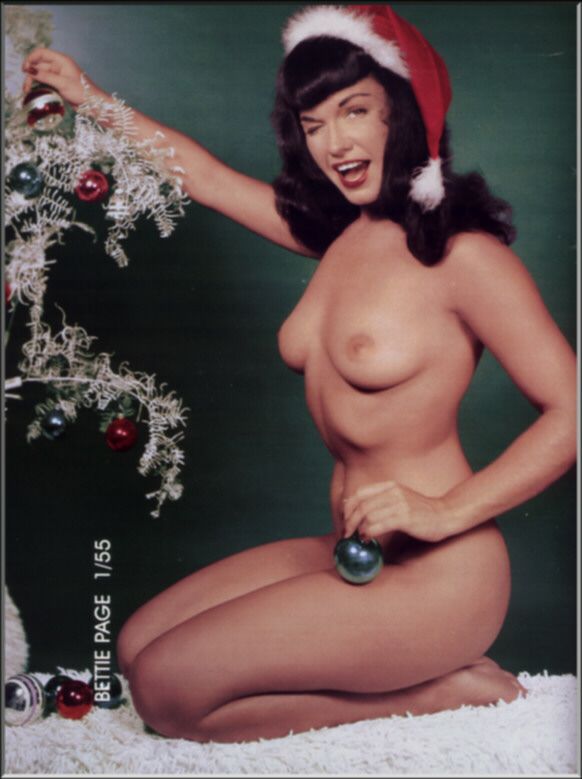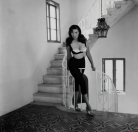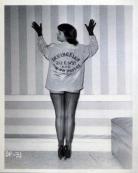Cheesecake for Christmas
Created by Savanah Green on Thu, 09/05/2024 - 00:45
This timeline provides a sociohistorical context for Bunny Yeager's 1955 Photograph of Bettie Page.

Timeline
Chronological table
| Date | Event | Created by | Associated Places | |
|---|---|---|---|---|
| 1950 to 1975 |
The Korean War, Vietnam War, and “Un-American” ActivitiesDuring more intense periods of The Cold War, such as the Korean War and Vietnam War, the United States government focused heavily on the indoctrination of its citizens as well as suppression of any social movements or social reform. As the government claimed to be squashing signs of communism, they attacked government officials, education systems, and figures in the entertainment industry. The entertainment industry took a significant hit, as censorship of anything deemed “un-American” was prevalent (Censored: Free Speech & Hollywood). The US government was especially known during this period to utilize television and other forms of media, such as radios and films in order to push propaganda and "American" political beliefs which would further its own agendas. For example, during the Korean War if media portrayed the military or war in a unfavorable light, the government would simply censor said media and place restrictions on what could be produced and broadcasted (Allen 3). Along with this form of censorship came the government’s attempts to portray the U.S. as a conservative nation of “high moral standards”. Magazines with provocative covers were considered immoral and this immorality was frequently considered a part of a large communist conspiracy to destroy the nation. This radical belief led to the burning of books, magazines, and any photographs considered “un-American” or obscene (Steele). In 1957, the beginning of the Vietnam War, Roth v. United States took place declaring obscenity is not protected under the first amendment of the United States constitution (Steele). Despite the usage of pin-up photos in soldier’s barracks, back home, repression of sexuality and sexual themes was rampant.
Allen, Alyssa. “The Change in U.S. Television News Throughout the Cold War.” The Alexandrian, XI, no. 1, 2022, pp. 1–8, https://journals.troy.edu/index.php/test/article/view/472/383. Accessed 04 Sept. 2024. “Censored: Free Speech & Hollywood: Discussion Guide.” PEN America, PEN America, 5 Feb. 2024, pen.org/censored-free-speech-hollywood-discussion-guide/. Accessed 04 Sept. Steele, Jennifer Elaine. “A history of censorship in the United States.” Journal of Intellectual Freedom & Privacy, vol. 5, no. 1, 12 Nov. 2020, pp. 6–19, https://doi.org/10.5860/jifp.v5i1.7208. Accessed 04 Sept. 2024. |
Savanah Green | ||
| circa. 1950 to circa. 1970 |
A Pioneer of the Feminist Art MovementBunny Yeager is one of the most prolific female photographers as well as the first female photographer to ever shoot for Playboy. Yeager had little competition as a female photographer in pin-up work and describes herself as a “trailblazer” to which I'd agree (Solomon). As both a pin-up model and photographer, she knew what looked best as well as what felt best for her subjects. Her work allowed flexible hours to pursue her passion, take care of a family, and maintain a career for herself in 1950s America. She employed many other women who were pin-ups working to support their families. Her work held a sense of agency for women and evinced the notion that women were also sexual beings and that could be a staple of femininity. Her work was said to inspire the work of Cindy Sherman, who is often referenced as a feminist artist and an icon among female photographers and artists (Schudel). Shermans work consisted of self-portraiture, which Bunny Yeager indulged in often and even wrote books about. When it comes to feminist ideals, Yeager herself said “I always hated it when people said, “You can do this as good as a man,” or “Why don't you do it like the men do it?” (Solomon).
The feminist art movement aimed to add women’s perspective to artwork. Women often made attempts to display and profit from their work but were rejected on the sole basis of being women (Feminist Art Movement). Artists like Bunny Yeager, who often profited from her work as both a photographer and subject, opened the door to make women’s successful career in art a large-scale possibility. Although her work did not make a clearly political declaration, her existence as a photographer alone held feminine power.
Solomon, Tara. “Bunny Yeager Talks Old-School Miami Glamour, Bettie Page and the Future of the Pin-up (NSFW).” HuffPost, HuffPost, 7 Dec. 2017, www.huffpost.com/entry/bunny-yeager-photography_b_2007159. Accessed 04 Sept. 2024. Schudel, Matt. “Bunny Yeager Dies; Revealing Images of Bettie Page Helped Define Art of Erotic Photography - The Washington Post.” The Washington Post, 2014, www.washingtonpost.com/entertainment/bunny-yeager-dies-revealing-images-of-bettie-page-helped-define-art-of-erotic-photography/2014/05/28/7caf4366-e5b4-11e3-afc6-a1dd9407abcf_story.html. Accessed 04 Sept. 2024. “Feminist Art Movement Overview and Analysis.” The Art Story, The Art Story Contributors, 2024, www.theartstory.org/movement/feminist-art/. Accessed 04 Sept. 2024. |
Savanah Green | ||
| 1952 to 1955 |
Bettie Page, Censorship, and Kefauver’s CampaignBettie Page has had multiple run-ins with the law regarding the controversial nature of nudity and the legal definition of pornography. In 1952, Page was charged with indecent exposure during a nude farmhouse shoot in Lewisboro, NY (Art Poses in Woods Brings $5 Fines to 27). After a local contacted the authorities, a squad car with multiple officers arrived at the location of the shoot and arrested the photographers for disturbing the peace and the models for indecent exposure (Bettie Page Reveals All). Bettie argued that what she was doing was not indecent and the charge was modified to disorderly conduct. In the same year, U.S. Senator Estes Kefauver was campaigning as a democratic presidential candidate. Kefauver’s campaign focused on organized crime, including the large-scale distribution of pornographic images and materials (Bettie Page Reveals All). A significant part of his campaign argued that pornographic and lewd material lead to juvenile delinquency. He lost the 1952, election, but continued his campaign against organized crime as a US Senator with the intent to run again for the 1956 democratic presidential candidate (Estes Kefauver: A Featured Biography). In 1955, Kefauver called Bettie Page to testify against photographer Irving Klaw claiming Klaw’s “pornography” influenced juvenile delinquency. Page stated Klaw never did nudes, he should not be charged as a pornographer. Many photos of Bettie and Klaw’s other models were confiscated by law enforcement. Page refused to testify against Klaw, and upon confronting Kefauver and the committee, Page was blamed for a 17-year-old boy committing suicide while looking at one of her bondage photographs. Page said she had nothing to do with that and defended her refusal to testify against Klaw, as she said he was not breaking any laws and she would not lie on the stand. Throughout her life, Bettie continued to defend her modeling work and emphasized the existence and importance of women’s sexuality (Bettie Page Reveals All).
“Art Poses in Woods Brings $5 Fines to 27.” The New York Times, The New York Times, 29 July 1952, www.nytimes.com/1952/07/29/archives/art-poses-in-woods-brings-5-fines-to.... Accessed 17 Aug. 2024. “Estes Kefauver: A Featured Biography.” Senate.Gov, United States Senate, www.senate.gov/senators/FeaturedBios/Featured_Bio_KefauverEstes.htm. Accessed 17 Aug. 2024. Mori, Mark, director. Bettie Page Reveals All. Music Box Films, 2012, https://www.amazon.com/Bettie-Page-Reveals-All/dp/B00J63UA66. Accessed 17 Aug. 2024. |
Savanah Green | ||
| Summer 2024 to Summer 2024 |
AnalysisBunny Yeager's 1955 Photograph of Bettie Page is greatly contextualized by the historical events presented. Many individuals would look at a photo of Bettie Page and purely see a pin-up model who is smiling for a picture. Maybe they are flipping the pages of a Playboy magazine looking for their next fix. Assumptions aside, this image was basically considered contraband in the 50s due to its lewdness. Today you could pull up a search engine and search for breasts and genitalia in under 20 seconds and no one would come knocking at your door. In the same year Page was photographed, with mere months in between, she was in court where she was forced to testify against her friends and colleagues of her field of work. The nation was in political distress due to fear of communism and images of Page were somehow dragged into the discussion. Hundreds of images of her were burned. This image is not only the kick starter of Bunny Yeager and Bettie Page’s prolific careers, but also boldly went against the conservative nature of American society at the time. Notably, Page also left the modeling industry 2 years later, the same year Roth v United States, which ruled obscenity was unprotected under the first amendment.
In this image, we see Page looking directly at the camera with a playful, yet assertive smile and wink on her face. She is having fun with what she is doing. She sees nothing wrong with it. It feels natural for her to be sporting only a Christmas hat. Page holds the agency when it comes to what is occurring between her and the viewer or photographer. Although, the photographer is Bunny Yeager, who is pin-up model herself. Yeager was the first woman photographer featured in Playboy with this image of Bettie Page. This image put Yeager on the map and displayed women as sexual beings by creation through the lens of a woman herself. This was taboo and typically not a successful field of work for women at the time. Between wars women were still fighting the battle between homemaker and member of the workforce. It took many years into the feminist art movement up until today for women to be taken seriously as artists. Women photographers and artists were often rejected from displaying or profiting from their work. Bunny Yeager truly was a gem of her time in the realm of both women and photographers.
Image Citations: Yeager, Bunny. Bunny Yeager (Self-Portrait). Etherton Gallery, 1956, https://ethertongallery.com/artists/108-bunny-yeager/works/10553-bunny-yeager-bunny-yeager-self-portrait-1956/. Accessed 05 Sept. 2024. Britannica, The Editors of Encyclopaedia. "Hollywood Ten". Encyclopedia Britannica, 28 Mar. 2024, https://www.britannica.com/topic/Hollywood-Ten. Accessed 05 September 2024. CMG Worldwide, www.cmgworldwide.com/2023/08/10/bettie-page-bunny-yeager/. Accessed 05 Sept. 2024. Drinnon, Benny. Bettie Page Advertising Irving Klaw, bennypdrinnon.blogspot.com/2015/12/bettie-page-advertising-irving-klaw.html. Accessed 05 Sept. 2024. |
Savanah Green |




